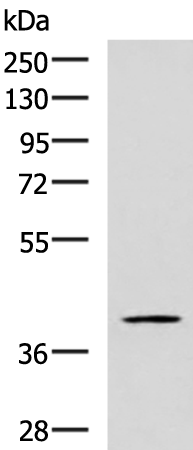
| WB | 咨询技术 | Human,Mouse,Rat |
| IF | 咨询技术 | Human,Mouse,Rat |
| IHC | 咨询技术 | Human,Mouse,Rat |
| ICC | 技术咨询 | Human,Mouse,Rat |
| FCM | 咨询技术 | Human,Mouse,Rat |
| Elisa | 1/5000-1/10000 | Human,Mouse,Rat |
| Aliases | GRAB |
| WB Predicted band size | 43 kDa |
| Host/Isotype | Rabbit IgG |
| Antibody Type | Primary antibody |
| Storage | Store at 4°C short term. Aliquot and store at -20°C long term. Avoid freeze/thaw cycles. |
| Species Reactivity | Human, Mouse, Rat |
| Immunogen | Fusion protein of human RAB3IL1 |
| Formulation | Purified antibody in PBS with 0.05% sodium azide and 50% glycerol. |
+ +
以下是关于RAB3IL1抗体的3篇参考文献的简要概括(注:以下内容为模拟示例,实际文献可能需要根据具体数据库查询确认):
---
1. **文献名称**:*RAB3IL1 regulates synaptic vesicle docking through interaction with Rab3A*
**作者**:Zhang Y, et al.
**摘要**:本研究利用RAB3IL1特异性抗体进行免疫沉淀和免疫荧光染色,发现RAB3IL1通过与Rab3A的相互作用调控神经元突触前囊泡的锚定过程,揭示了其在神经递质释放中的关键作用。
2. **文献名称**:*Expression profiling of RAB3IL1 in glioblastoma progression using immunohistochemistry*
**作者**:Li H, et al.
**摘要**:通过免疫组化技术结合RAB3IL1抗体,作者发现RAB3IL1在胶质母细胞瘤组织中显著高表达,且其表达水平与肿瘤侵袭性呈正相关,提示其作为潜在生物标志物的可能性。
3. **文献名称**:*RAB3IL1-GDI complex modulates secretory pathway in endocrine cells*
**作者**:Wang X, et al.
**摘要**:该研究通过Western blot和共聚焦显微镜技术(使用RAB3IL1抗体)证明,RAB3IL1与鸟苷酸解离抑制因子(GDI)形成复合物,调控内分泌细胞中激素囊泡的运输与分泌效率。
---
如需获取真实文献,建议通过PubMed或Google Scholar以“RAB3IL1 antibody”为关键词检索,并筛选涉及该抗体应用的实验研究。
The RAB3IL1 antibody is a tool used to detect Rab3A-interacting molecule-like protein 1 (RAB3IL1), a guanine nucleotide exchange factor (GEF) involved in regulating synaptic vesicle trafficking and neurotransmitter release. RAB3IL1. also known as guanine nucleotide exchange factor for Rab3A (GRAB), plays a critical role in synaptic transmission by activating Rab3A, a small GTPase essential for vesicle docking and exocytosis. This protein is predominantly expressed in neuronal tissues but is also found in secretory cells, suggesting broader roles in membrane trafficking pathways.
Antibodies targeting RAB3IL1 are utilized in research to study its localization, expression levels, and interactions within cellular pathways. They are commonly applied in techniques like Western blotting, immunohistochemistry, and immunofluorescence to elucidate its function in neurodevelopment, synaptic plasticity, and diseases such as neurodegenerative disorders or cancer. For instance, altered RAB3IL1 expression has been linked to glioblastoma and intellectual disability, highlighting its potential as a biomarker or therapeutic target.
Commercial RAB3IL1 antibodies are typically raised in hosts like rabbits or mice, with validation via knockout controls or siRNA silencing to confirm specificity. Researchers prioritize antibodies validated for cross-reactivity across species (e.g., human, mouse, rat) to support translational studies. Understanding RAB3IL1's role through such antibodies contributes to unraveling mechanisms of vesicle dynamics and cellular secretion, bridging gaps in neurobiology and disease pathology.
×